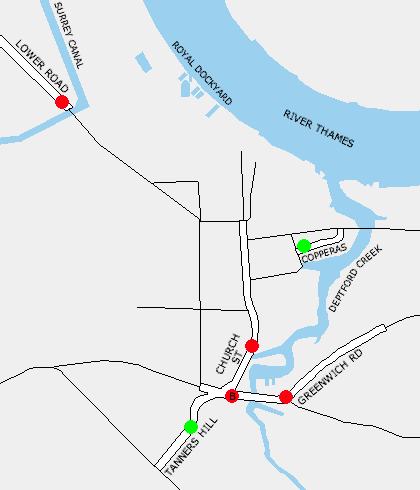The odd few references crop up for refining in the Deptford area even though at the time the markets for raw sugar and the finished products were way up river.
What is significant about Deptford is its pottery. We know from the directories that there were two sugar mould potteries, one in Copperas Lane, the other in Tanner's Hill, either side of 1800, however there is archaeological evidence of mould making considerably earlier.
Potteries in Greenwich produced earthenware vessels in the 16thC, and similar were established in Deptford in the 17thC.
In the autumn of 1997 an archaeological excavation was conducted on the site of the former Deptford power stations, previously built on the land bounded by the Thames to the north, the Depford Creek to the east and Creek Rd to the south. The important early occupants of parts of the site were the dockyard founded by the East India Company, and the Trinity House almshouses.
The excavation report by David Divers (see notes) was published in 2004 and the final paragraph of the initial summary reads ...
"The manufacture of pottery is another known activity on the site during the 18th century. No structural remains of any pottery were found, although a large quantity of pottery wasters and kiln waste was retrieved from land reclamation dumps."
Within the report, the detail, by Chris Jarrett, describes a series of pottery production waste dumps, containing late 17thC and 18thC wasters, found within the dock structure. These dumps had either served to consolidate the foreshore or assist in the construction of a new revetment. The reclaimed dockyard was completed before 1789, and it is thought the wasters were collected elsewhere and later moved in sufficient quantities when needed at the waterfront as the kiln waste was at least 50 years old before it was used as construction material.
Dating the sugar moulds found at Deptford was mainly based upon whether or not they were slip-coated, a process introduced in the late 17thC. Information from other sites would indicate the moulds dated from after c1680, maybe even the 1740s if they had been stored before use. As would be expected, a variety of sugar moulds and collecting pots were found, though as obviously none were complete the heights of the moulds could not be determined, only the rim diameters. They were Deptford redware and the majority of the moulds were white slip-coated internally.
The River Thames would have been an ideal means of transporting the finished moulds and pots to the London sugarhouses.
The full excavation report is published as ...
Post-Medieval Archaeology 38/1 (2004), 17-132 ... "Excavations at Deptford on the site of the East India Company dockyards and the Trinity House almshouses, London" by David Divers (with others), Society for Post-Medieval Archaeology, 2004.
There is a shorter version "Excavations at the mouth of Deptford Creek, Greenwich Reach" by David Divers & Chris Jarrett online.
There is an image of a Deptford Pottery at British Library Online Gallery.
See the page on sugar moulds and collecting pots ... here







